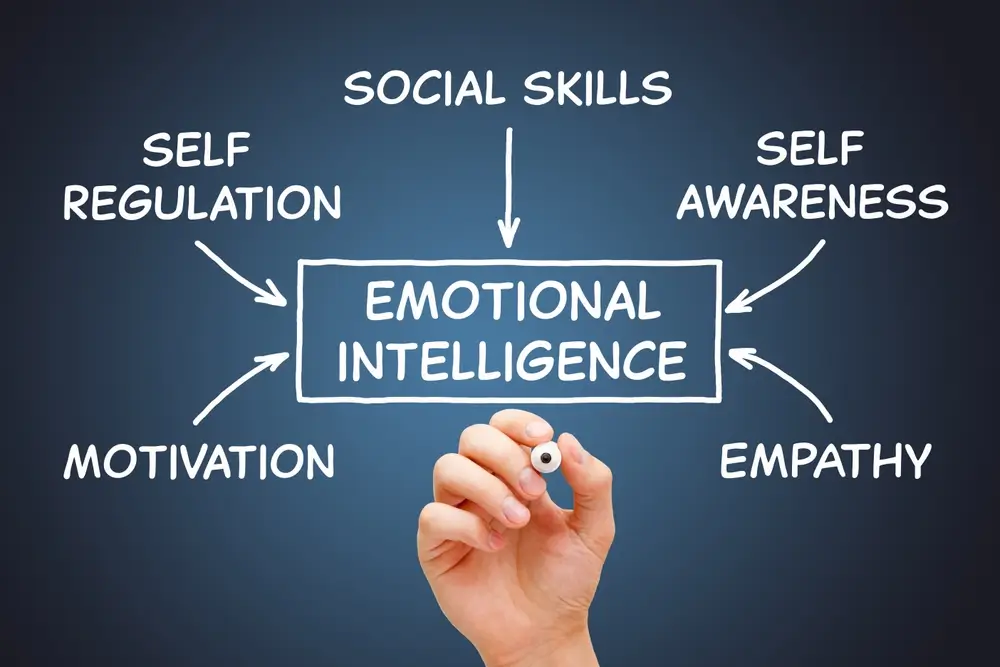How does emotional intelligence, or as it is also referred to emotional quotient (EQ), figure in today’s narrative on effective leadership?
When I started my career in the late 1980s leadership was measured almost exclusively by numbers: sales targets hit, contracts signed, KPIs achieved. Collaboration, emotional insight or inclusion? They were not measured as part of a performance appraisal.
What is Emotional Intelligence?
Today emotional intelligence, is considered to be the ‘capacity to be aware of, control and express one’s emotions and to handle interpersonal relationships judiciously and empathetically.’ It has become a core leadership skill!
According to the book ‘Emotional Intelligence: Why it matters more than IQ’ these skills consist of five core components: empathy, effective communication or social skills, self-awareness, self-regulation and motivation. Goleman, D (1995).
The term EQ originated in the mid-1960s and then in 1983 the concept featured in a book by Howard Gardner titled ‘Frame of Minds: The theory of multiple intelligences.’
It arguably did not gain attention in a business context until Goleman in 1995, when he contended that EQ is a better indicator of business success than cognitive intelligence or IQ.’
From my experience EQ, didn’t start appearing meaningfully in leadership appraisals until the mid to late 2,000s.
My Experience: How EQ Became Essential
Over a span of 20+ years, my generation (Gen X), managed by Baby Boomers I & II * started to see a shift in management styles with greater use of Performance Appraisals and Management by Objectives (MBOs) to drive the desired behaviours.
It is during the period between the early to mid-1990s and 2008/09 that I started to see more attention placed on the emotional intelligence aspects of the job, not just for managers but also for employees.
- I found one of my performance appraisal forms from the early 1990s and the ‘Job responsibilities and Ratings’ were decided by the Manager alone. There were no pre-defined categories of assessment and nothing concerning inclusion or collaboration.
- In 1998, I found an appraisal that included ratings for your ‘Business Conduct’ and ‘Supporting and Managing Diversity.’
- In 2003, additional predefined categories included ‘Coaches for Performance,’ ‘Builds Collaborative Relationships’ and ‘Takes a consultative Approach.’
- In 2008, ‘Inclusion’ became a rating defined as ‘works collectively with all co-workers’ and ‘treats everyone with dignity and respect.’ Leadership also included the requirement to be ‘considered a key resource by others.’
- I have seen performance appraisals from 2017 with additional evaluation categories that included ‘mentoring and supporting development’ and ‘Attitude and Commitment’ defined as ‘showing a positive attitude and demonstrating a commitment to his / her team, colleagues and clients.’
Let’s be clear the main criteria for keeping your job and progressing in your career was and still is to ‘hit your KPIs’ and that, in large part, determined your compensation and performance rating as a salesperson / manager. But gradually other factors were being considered as part of an overall performance appraisal.
1998 was a little early for Millennials to have entered the workplace, but arguably by 2003 and 2008 early millennials will have been making an impact. Possibly influencing the way managers engaged with their employees, combined with a greater understanding of EQ.
So, in summary.
Positive Attitude – assessed in appraisals as ‘Attitude and Commitment.’
Resilience and Managing Stress – assessed in appraisals as ‘Business Conduct’ Can you manage stress, are you resilient and do you always have a positive attitude? Is this visible to employees and clients?
Leading Others and Building Collaborative relationships– assessed in appraisals as ‘Supporting and managing diversity.’ Can you build a broad coalition of support internally across multiple functions, cultures, educations, and socio-economic backgrounds?
The only attribute that remains difficult to classify, in the context of an employee appraisal process, is Self-Awareness. With that piece missing other demonstrations of Emotional Intelligence may be less evident. This can however, potentially be picked up during a 360-feedback exercise.
What EQ looks like in Real-World Leadership.
Here is what emotional intelligence means when leading people.
- Trust.
Earn trust by being reliable, discrete and fair. - Communication.
Stay calm, clear and consistent, even under pressure. - Values.
Lead with integrity, compassion, resilience and openness. - Coaching.
Share experiences and mentor without micromanaging. - Support.
Step in when needed and lead by example. - Work Ethic.
Be available when the team needs you, not just during normal office hours. - Leadership.
Shield your team from unnecessary noise while still pushing for accountability and resilience.
Why Self-Awareness is the Foundation.
Without self-awareness, none of these behaviours are sustainable. You can’t build trust, mentor effectively, or navigate pressure if you don’t first understand your own strengths, blind spots and emotional responses.
It is important to look at EQ as an additional skill, rather than as a replacement for other leadership qualities. In any business the primary objective is to achieve targets and deliver for both shareholders and clients. However, EQ can play a role in helping you get the best out of employees and in creating a positive work environment where people feel valued and supported.
Self-awareness unlocks emotional intelligence. Emotional intelligence enables leadership success.
Conclusion: The Real Competitive Advantage
Over 20+ years and particularly in today’s fast moving, complex work environments, I have seen leaders with high EQ inspire loyalty, drive better collaboration, build resilience and consistently outperform those that focused on performance metrics alone.
In today’s world, IQ might open the door, but EQ puts you at the head of the table.
If you need help developing your team to lead, we can help!



